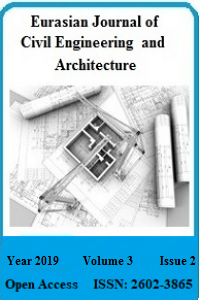Abstract
References
- A. Korobenko, M. C. Hsu, I. Akkerman, J. Tippmann, and Y. Bazilevs, “Structura lmechanics modeling and FSI simulation of wind turbines,” Mathematical Models and Methods in Applied Sciences, vol. 23, no. 2, pp. 249–272, 2013.
- ANSYS Fluent Users Guide, ANSYS, Canonsburg, PA, USA, 2013.
- CERC. (2002). Coastal engineering manual, Wave Mechanics, Part II, USA.
- Christensen, E. D., Hansen, Yde, E. A. L., Tarp-Johansen, Gravesen, N. J. H., and Damsgaard, M. L., “Wave loads on offshore wind turbine foundations in shallow water: engineering models vs. refined flow modelling,” in Proceedings of the European Offshore Wind Conference, pp. 4–6, Berlin, Germany, December 2007.
- Dagli, B. Y., Tuskan, Y., & Gökkuş, Ü. (2018). Evaluation of Offshore Wind Turbine Tower Dynamics with Numerical Analysis. Advances in Civil Engineering, 2018.
- Ergin, A., 2009. Coastal Engineering. Metu Press. Turkey.
- Friez, P.A., 2011. Offshore Structure Design and Construction. Ships and Offshore Structures. Encyclopedia of Life SupportSystems. UK.
- Karadeniz, H. (2001). Uncertainty modeling in the fatigue reliability calculation of offshore structures. Reliability Engineering & System Safety, 74(3), 323-335.
- Kudale, M. D. and Bhalerao, A. R., “Equivalent monochromatic wave height for the design of coastal rubble mound structures,” Aquatic Procedia, vol. 4, pp. 264–273, 2015.
- Lee, M. M. K., (1999).Strength, stress and fracture analyses of offshore tubular joints using finite elements, Journal of Constructional Steel Research, vol. 51, no. 3, pp. 265–286.
- Nizamani, Z., 2015. Environmental Load Factors and System Strength Evaluation of Offshore Jacket Platforms. Springer International Publishing, Switzerland.
- Telecommunications Industry Association (TIA), 2005, Structural Standards For Steel Antenna Towers And Supporting Structures. USA, 120p.
- Versteeg, H.K., 2007. Malalaseker, An introduction to Computational Fluid Dynamics. The Finite Volume Method. Pearson Education. Longman Scientific Technical. England.
- Wei,K., Arwade, S. R., and Myers, A. T., “Incrementalwindwaveanalysis of thestructuralcapacity of offshore wind turbinesupportstructuresunderextremeloading,” EngineeringStructures, vol. 79, pp. 58–69, 2014.
Abstract
In this study,
fluid-structure interaction problem is investigated by solidity ratio approach.
In the first case (Case I) steady flow conditions are defined by using air as
fluid. The wind forces acting on the space lattice systems are determined by
considering the solidity ratio dictated by ANSI/TIA-222-G (Steel Antenna Towers
and Antenna Supporting Structures) technical specification. Stability of wind
tower is analyzed using SAP 2000 software program. In the second case (Case II)
unsteady flow conditions are evaluated by utilizing water waves acting on
lattice marine structures. Models are occurred two groups as three space frame
structures and three porous media models. Hydrodynamic wave forces are
represented by the Stoke’s Second Order wave theory. Morison equation is
employed to obtain lateral wave forces. The results of computational fluid
dynamics are performed by using ANSYS-Fluent software. Solidity ratio is used
to observe vortex effect that is based on turbulence around the structural
members. The hydrodynamic forces acting on the marine structures are presented
independent from configuration, depending on solidity ratio values.
References
- A. Korobenko, M. C. Hsu, I. Akkerman, J. Tippmann, and Y. Bazilevs, “Structura lmechanics modeling and FSI simulation of wind turbines,” Mathematical Models and Methods in Applied Sciences, vol. 23, no. 2, pp. 249–272, 2013.
- ANSYS Fluent Users Guide, ANSYS, Canonsburg, PA, USA, 2013.
- CERC. (2002). Coastal engineering manual, Wave Mechanics, Part II, USA.
- Christensen, E. D., Hansen, Yde, E. A. L., Tarp-Johansen, Gravesen, N. J. H., and Damsgaard, M. L., “Wave loads on offshore wind turbine foundations in shallow water: engineering models vs. refined flow modelling,” in Proceedings of the European Offshore Wind Conference, pp. 4–6, Berlin, Germany, December 2007.
- Dagli, B. Y., Tuskan, Y., & Gökkuş, Ü. (2018). Evaluation of Offshore Wind Turbine Tower Dynamics with Numerical Analysis. Advances in Civil Engineering, 2018.
- Ergin, A., 2009. Coastal Engineering. Metu Press. Turkey.
- Friez, P.A., 2011. Offshore Structure Design and Construction. Ships and Offshore Structures. Encyclopedia of Life SupportSystems. UK.
- Karadeniz, H. (2001). Uncertainty modeling in the fatigue reliability calculation of offshore structures. Reliability Engineering & System Safety, 74(3), 323-335.
- Kudale, M. D. and Bhalerao, A. R., “Equivalent monochromatic wave height for the design of coastal rubble mound structures,” Aquatic Procedia, vol. 4, pp. 264–273, 2015.
- Lee, M. M. K., (1999).Strength, stress and fracture analyses of offshore tubular joints using finite elements, Journal of Constructional Steel Research, vol. 51, no. 3, pp. 265–286.
- Nizamani, Z., 2015. Environmental Load Factors and System Strength Evaluation of Offshore Jacket Platforms. Springer International Publishing, Switzerland.
- Telecommunications Industry Association (TIA), 2005, Structural Standards For Steel Antenna Towers And Supporting Structures. USA, 120p.
- Versteeg, H.K., 2007. Malalaseker, An introduction to Computational Fluid Dynamics. The Finite Volume Method. Pearson Education. Longman Scientific Technical. England.
- Wei,K., Arwade, S. R., and Myers, A. T., “Incrementalwindwaveanalysis of thestructuralcapacity of offshore wind turbinesupportstructuresunderextremeloading,” EngineeringStructures, vol. 79, pp. 58–69, 2014.
Details
| Primary Language | English |
|---|---|
| Journal Section | Articles |
| Authors | |
| Publication Date | December 1, 2019 |
| Published in Issue | Year 2019 Volume: 3 Issue: 2 |
Cite
Creative Commons License
Attribution-NonCommercial-ShareAlike 4.0 International (CC BY-NC-SA 4.0)

Creative Commons Attribution-NonCommercial-ShareAlike (CC BY-NC-SA) License lets others remix, tweak, and build upon the work non-commercially, as long as they credit the author(s) and license their new creations under the identical terms.


